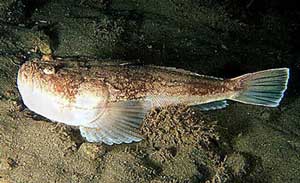Sand stargazers are blennioids; perciform marine fish of the family Dactyloscopidae. Found in temperate to tropical waters of North and South America; some may also inhabit brackish environments. The giant sand stargazer is the largest at 15 cm in length; all other species are under 10 cm.

The stargazers are a family, Uranoscopidae, of perciform fish that have eyes on top of their heads. The family includes about 51 species in eight genera, all marine and found worldwide in shallow and deep saltwaters.
Crapatalus novaezelandiae, is a species of southern sandfish endemic to the Pacific waters around New Zealand. It occurs in shallow sandy areas, particularly harbours and estuaries. Its length is up to 45 cm.
Dactyloscopus is a genus of sand stargazers native to the coasts of the Americas.

A bottom feeder is an aquatic animal that feeds on or near the bottom of a body of water. Biologists often use the terms benthos—particularly for invertebrates such as shellfish, crabs, crayfish, sea anemones, starfish, snails, bristleworms and sea cucumbers—and benthivore or benthivorous, for fish and invertebrates that feed on material from the bottom. However the term benthos includes all aquatic life that lives on or near the bottom, which means it also includes non-animals, such as plants and algae. Biologists also use specific terms that refer to bottom feeding fish, such as demersal fish, groundfish, benthic fish and benthopelagic fish. Examples of bottom feeding fish species groups are flatfish, eels, cod, haddock, bass, grouper, carp, bream (snapper) and some species of catfish and sharks.

Stargazer is the eighth album by jazz trumpeter Dave Douglas. It was released in 1997 on Arabesque Records. The album features performances by Douglas, Chris Speed, Josh Roseman, Uri Caine, James Genus and Joey Baron, and includes Douglas' interpretations of three compositions by Wayne Shorter.
Dactylagnus is a genus of sand stargazers, found in the eastern central Pacific and western central Atlantic Ocean.
Gillellus is a genus of sand stargazers, found in the eastern central Pacific Ocean and western central Atlantic Ocean.
Heteristius cinctus, the banded stargazer, is a species of sand stargazer native to the Pacific coast of the Americas from Baja California, Mexico to Ecuador where it can be found on sandy bottoms at depths of from 1 to 27 m. It can reach a maximum of 4.5 cm (1.8 in) in total length. This species is currently the only known member of its genus.
Leurochilus acon, the Smoothlip stargazer, is a species of sand stargazer native to the waters around the Caribbean islands of the Bahamas, the Virgin Islands, Antigua and Cuba where it can be found on bottoms consisting of sand, marl and rock at depths from near the surface to 8 metres (26 ft). It can reach a maximum length of 2.9 centimetres (1.1 in) SL. This species is currently the only known member of its genus.
Myxodagnus is a genus of sand stargazers, native to the Pacific and Atlantic coastal waters of the Americas.

Platygillellus is a genus of sand stargazers native to the Atlantic and Pacific coasts of the Americas.

Uranoscopus is a genus of stargazer fish from the family Uranoscopidae. The name Uranoscopus is from the Greek, ouranos, "sky" and skopein, "to watch".

The southern stargazer is a species of marine fish in the family Uranoscopidae and genus Astroscopus. They are native to the United States.
Ian Stafford Ross Munro (1919–1994) was an Australian ichthyologist and marine biologist who worked for CSIRO from 1943 until his retirement. From 1963 he led the Gulf of Carpentaria Prawn Survey. He is honoured in the specific name of the fish Crapatalus munroi.

Astroscopus, the electric stargazers, is a genus of stargazers, a type of percomorph fish from the family Uranoscopidae, part of the order Labriformes. The species in this genus are anatomically distinct uranoscopids, being characterized by internal nares and being the only group of marine bony fish having organs which produce electricity which are derived from the extraocular muscles. They are found on the Atlantic and Pacific coasts of the Americas.

Kathetostoma is a genus of bony fish from the family Uranoscopidae, the stargazers. They are demersal predators which are found in the western Atlantic, Pacific and Indian Oceans, with most species around Australia and New Zealand.
The scaly stargazer is a stargazer of the family Uranoscopidae. It is a demersal species which has been recorded at depths between 40 and 800 metres, although it is most commonly recorded at 200–400 metres (660–1,310 ft). It has a maximum length of 33 centimetres (13 in). It is found in the South Atlantic, southern Indian Ocean and south western Pacific Ocean; in the South Atlantic it has been recorded from the Rio Grande Rise and the Walvis Ridge to the coasts of Namibia around southern Africa to the Madagascar Ridge, south of the island of Madagascar, in the south western Indian Ocean; in Australia it occurs from Western Australia and northern New South Wales, around New Zealand, and it also occurs on ocean ridge near Norfolk Island. It is the only species in the monotypic genus Pleuroscopus.
Uranoscopus brunneus, the dark-finned stargazer, is a member of the group Uranoscopidae, the benthic living fishes distributed worldwide in tropical and temperate oceans.








